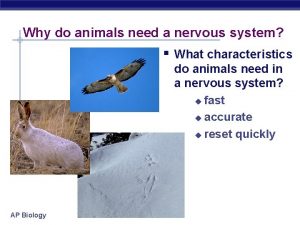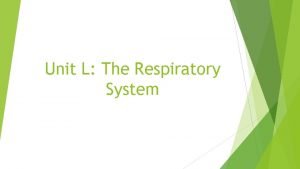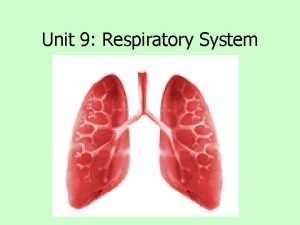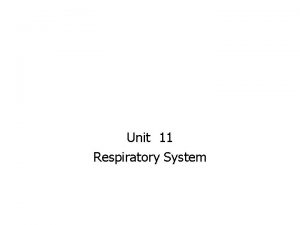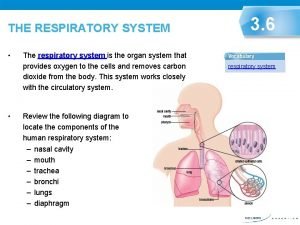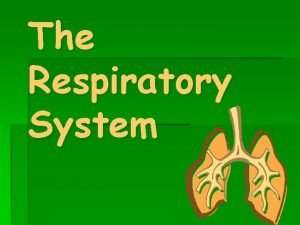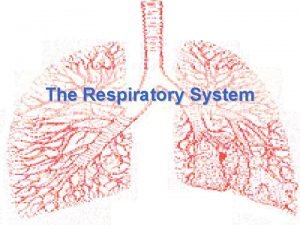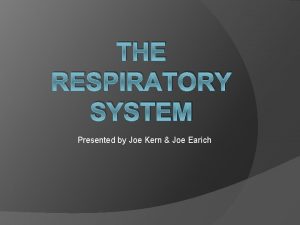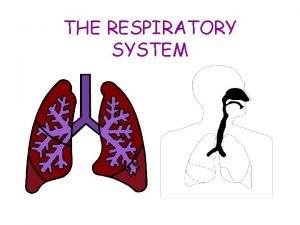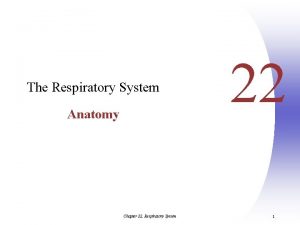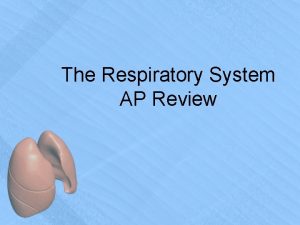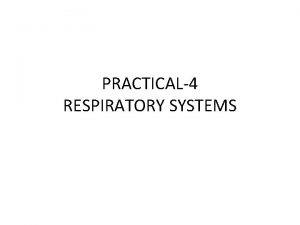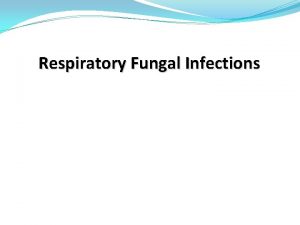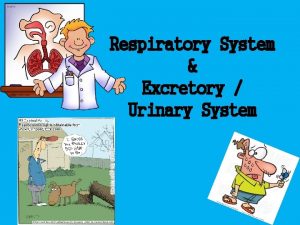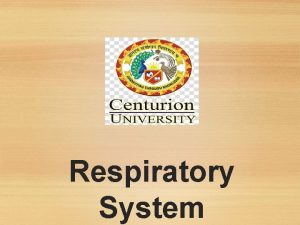Why do we need a respiratory system Need


















- Slides: 18

Why do we need a respiratory system? § Need O 2 in for aerobic cellular respiration u make ATP u § Need CO 2 out u food waste product from Krebs cycle O 2 AP Biology ATP CO 2

Optimizing gas exchange § High surface area maximizing rate of gas exchange u CO 2 & O 2 move across cell membrane by diffusion u § rate of diffusion proportional to surface area § Moist membranes moisture maintains cell membrane structure u gases diffuse only dissolved in water u AP Biology

Gas exchange in many forms… one-celled amphibians echinoderms insects fish mammals cilia AP Biology • size water vs. land • endotherm vs. ectotherm

Counter current exchange system § Water carrying gas flows in one direction, blood flows in opposite direction AP Biology

How counter current exchange works 70% front 40% 100% back 15% water 60% 30% counter 90% 5% current blood 50% 70% 100% 50% 30% concurrent water 5% blood § Blood & water flow in opposite directions u AP Biologyu maintains diffusion gradient over whole length of gill capillary maximizing O 2 transfer from water to blood

Gas Exchange on Land § Advantages of terrestrial life u air has many advantages over water § higher concentration of O 2 § O 2 & CO 2 diffuse much faster through air § air is much lighter than water & therefore much easier to pump § Disadvantages u keeping large respiratory surface moist causes high water loss § Internal lungs AP Biology

Terrestrial adaptations Tracheae § air tubes branching throughout body § gas exchanged by diffusion across moist cells AP Biology

Lungs Exchange tissue: spongy texture, moist epithelium §Air enters nostrils §Pharynx glottis larynx (vocal cords) trachea (windpipe) bronchioles air sacs (alveoli) §Epithelial lining covered by cilia & thin film of mucus

Alveoli § Gas exchange across thin epithelium of millions of alveoli u AP Biology total surface area in humans ~100 m 2

Negative pressure breathing § Breathing due to changing pressures in lungs u AP Biology pulling air instead of pushing it

Autonomic breathing control § Medulla sets rhythm & pons moderates it u measures p. H of blood & cerebrospinal fluid bathing brain w CO 2 + H 2 O H 2 CO 3 (carbonic acid) § if p. H decreases then increase rate of breathing & excess CO 2 is eliminated in exhaled air Nerve sensors in walls of aorta & carotid arteries in neck detect O 2 & CO 2 in blood

Diffusion of gases § Concentration gradient & pressure drives movement of gases into & out of blood at both lungs & body tissue capillaries in lungs AP Biology capillaries in muscle O 2 O 2 CO 2 blood lungs blood body

Hemoglobin § Why use a carrier molecule? u O 2 not soluble enough in H 2 O for animal needs § hemocyanin in insects = copper (bluish/greenish) § hemoglobin in vertebrates = iron (reddish) § Reversibly binds O 2 u loading O 2 at lungs or gills & unloading at cells heme group AP Biology cooperativity

Cooperativity in Hemoglobin § Binding O 2 u binding of O 2 to 1 st subunit causes shape change to other subunits § conformational change u increasing attraction to O 2 § Releasing O 2 u when 1 st subunit releases O 2, causes shape change to other subunits § conformational change u AP Biology lowers attraction to O 2

O 2 dissociation curve for hemoglobin § drop in p. H lowers affinity of Hb for O 2 § active tissue (producing CO 2) lowers blood p. H & induces Hb to release more O 2 AP Biology % oxyhemoglobin saturation Bohr Shift Effect of p. H (CO 2 concentration) 100 90 80 70 60 50 40 30 20 10 0 p. H 7. 60 p. H 7. 40 p. H 7. 20 More O 2 delivered to tissues 0 20 40 60 80 100 PO 2 (mm Hg) 120 140

O 2 dissociation curve for hemoglobin Effect of Temperature § increase in temperature lowers affinity of Hb for O 2 § active muscle produces heat % oxyhemoglobin saturation Bohr Shift 100 90 80 20°C 37°C 70 60 50 40 30 20 10 0 More O 2 delivered to tissues 0 AP Biology 43°C 20 40 60 80 PO 2 (mm Hg) 100 120 140

Transporting CO 2 in blood § Dissolved in blood plasma as bicarbonate ion Tissue cells carbonic acid CO 2 + H 2 O H 2 CO 3 CO 2 carbonic anhydrase bicarbonate H 2 CO 3 H+ + HCO 3– AP Biology CO 2 dissolves in plasma CO 2 combines with Hb Plasma Carbonic anhydrase CO 2 + H 2 O H 2 CO 3 H+ + HCO 3– Cl– HCO 3–

Releasing CO 2 from blood at lungs § Lower CO 2 pressure at lungs allows CO 2 to diffuse out of blood into lungs Lungs: Alveoli CO 2 dissolved in plasma CO 2 + H 2 O – + 3 + H Hemoglobin + COHCO 2 AP Biology Plasma HCO 3–Cl– H 2 CO 3
 Conducting zone of the respiratory system
Conducting zone of the respiratory system Pictures
Pictures Site:slidetodoc.com
Site:slidetodoc.com How respiratory system work with circulatory system
How respiratory system work with circulatory system Circulatory system and respiratory system work together
Circulatory system and respiratory system work together Why do animals need a nervous system
Why do animals need a nervous system Don't ask why why why
Don't ask why why why Respiratory system bozeman
Respiratory system bozeman Unit 9 respiratory system
Unit 9 respiratory system Diagnostic test of respiratory system
Diagnostic test of respiratory system What is the respiratory system
What is the respiratory system Respiratory system function
Respiratory system function Respiratory system coloring page
Respiratory system coloring page Respiratory system purpose
Respiratory system purpose Conclusion respiratory system
Conclusion respiratory system The energy-releasing process that is fueled by oxygen
The energy-releasing process that is fueled by oxygen Cengage learning chapter 7 answers
Cengage learning chapter 7 answers Chapter 13 the respiratory system
Chapter 13 the respiratory system Respiratory system
Respiratory system





